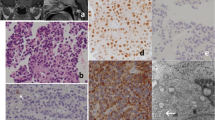Abstract
The presence of heat-shock protein 72 (HSP-72) was investigated by immunohistochemistry (IHC) in a series of 28 surgically removed pituitary adenomas including six somatotroph, two mammosomatotroph, five lactotroph, six corticotroph, four null cell adenomas, and three oncocytomas. Overall, 25 tumors (90%) were positive for HSP-72. One somatotroph, one lactotroph, and one null cell adenomas each contained only sparse, small HSP-72 immunoreactive granules and were regarded as negative. The expression of HSP-72 was commonly uneven differing in degree from cell to cell and among various tumors. In most adenomas, the immunoreactivity was seen as fine granules of moderate density, distributed throughout the cytoplasm. In some cells, the immunoreactivity was strong and diffuse. In one somatotroph, two corticotroph, one null cell, and one oncocytic adenomas, nearly all tumor cells were strongly positive. Adenoma cells, located adjacent to capillaries and small vessels, commonly showed a selective and strong immunoreactivity for HSP-72. The fragments of nontumorous adenohypophysial parenchyma also contained fine immunoreactive cytoplasmic granules accumulating in scattered hormone-producing cells and in stellate cells. These results show that HSP-72 is expressed in most pituitary adenomas with a mostly focal and less frequently diffuse pattern of overexpression.
Similar content being viewed by others
References
Morimoto, R. I., Tiessieres, A., and Georgopoulos, C. (1990). In:The stress proteins in biology and medicine, Morimoto, R. I., Tiessieres, A., and Georgopoulos, C. (eds). Cold Spring Harbor: New York.
Welch, W. J. (1992).Physiol. Rev. 72, 1063–1081.
Ang, D., Libererk, K., Skowyra, D., Zylicz, M., and Georgopoulos, C. (1991).J. Biol. Chem.,266, 24,233–24,236.
Pechan, P. M. (1991).FEBS Lett. 280, 1–4.
Michishita, M., Satoch, M., Yamaguchi, M., Hirayoshi, K., Okuma, M., and Nagata, K. (1991).Biochem. Biophys. Res. Commun. 176, 979–984.
Lehman, T. A., Bennett, W. P., Metcalf, R. A., Welch, J. A., Ecker, J., Modali, R. V., Ullrich, S., Romano, J. W., Appella, E., Testa, J. R., Gerwin, B. I., and Harris, C. C. (1991).Cancer Res. 51, 4090–4096.
Pinhashi-Kimhi, O., Michalovitz, D., Ben-Zeev, A., and Oren, M. (1986).Nature 320, 182–185.
Wallin, G., Bronnegard, M., Grimelius, L., McGurie, J., and Torring, O. (1992).Thyroid 2, 307–313.
Beato, M. (1989).Cell 56, 335–344.
Fuqua, S. A. W., Blum-Salingaros, M., and McGuire, W. L. (1989).Cancer Res. 49, 4126–4129.
Smith, D. F. and Toft, D. O. (1993).Mol. Endocrinol. 7, 4–11.
Kontogeorgos, G., Kovacs, K., and Asa, S. L. (1995).Endocr. Pathol. 6, 257–265.
Wilkinson, J. M. and Pollard, J. (1993).Anatom. Rec. 237, 453–457.
Kato, S., Hirano, A., Kato, F., and Ohama, E. (1992).Acta Neuropathol. 83, 261–264.
Kato, M., Herz, F., and Hirano, A. (1992).Acta Neuropathol. 83, 420–422.
Gandour-Edwards, R., Kapadia S. B., Janecka, I. P., Martinez, A. J., and Barnes, L. (1995).Mod. Pathol. 8, 160–164.
Marin, F., Cheng, Z., and Kovacs, K. (1993).Arch. Pathol. Lab. Med. 117, 245–258.
Welch, W. J. and Suhan, J. P. (1986).J. Cell. Biol. 103, 2035–2052.
Li, Y., Chopp, M., Garcia, J. H., Yoshida, Y., Zhang, Z. G., and Levine, S. R. (1992).Acta Neuropathol. 84, 94–99.
Chopp, M., Li, Y., Dereski, M. O., Levine, S. R., Yoshida, Y., and Garcia, J. H. (1992).Stroke 23, 104–107.
Hamos, J. E., Oblas, B., Pulaski-Salo, D., Welch, W. J., Bole, D. G., and Drachman, D. A. (1991).Neurology 41, 345–350.
Stefaneanu, L., Kovacs, K., Horvath, E., Lloyd, R. V., Buchefelder, M., Falbusch, R., and Smyth, H. (1994).J. Clin. Endocrinol. Metab. 78, 83–88.
Horvath, E., Kovacs, K., Scheithauer, B. W., Randall, R. V., Laws, E. R. Jr., Thorner, M. O., Tindall, G. T., and Barrow, D. L. (1983).Ultrastruct. Pathol. 5, 171–183.
Kontogeorgos, G., Kovacs, K., Horvath, E., Scheithauer, B. W., Rologis, D., and Orphanidis, G. (1991).Modern Pathol. 4, 191–195.
Kontogeorgos, G., Kovacs, K., Horvath, E., and Scheithauer, B. W. (1993).Endocr. Pathol. 4, 20–27.
Author information
Authors and Affiliations
Corresponding author
Rights and permissions
About this article
Cite this article
Kontogeorgos, G., Stefaneanu, L. & Kovacs, K. Stress-response proteins in human pituitary adenomas. Endocr 6, 25–29 (1997). https://doi.org/10.1007/BF02738798
Received:
Revised:
Accepted:
Issue Date:
DOI: https://doi.org/10.1007/BF02738798




